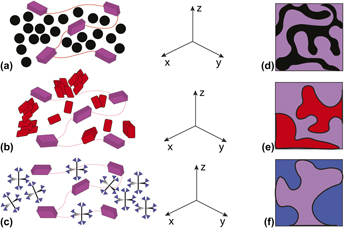Article contents
Toward a better understanding of conjugated polymer blends with non-spherical small molecules: coupling of molecular structure to polymer chain microstructure
Published online by Cambridge University Press: 05 January 2017
Abstract

A major obstacle in the organic solar cell field is the inability to predict the relevant microstructural length scales that determine charge transport of the interpenetrating polymer/small molecule network based on the component chemical structures. This has led to a trial-and-error approach, which is extremely labor-intensive. This manuscript is our attempt to move toward forming a link between small molecule chemical structure and the morphological hierarchy of the blend. We focus on geometric motifs of small molecule organic semiconductors which have 2D, nonspherical 3D, and quasispherical 3D molecular orbital extent. We find that phase separation in these blends is a function of the molecular structure, and that the small molecule chemical structure is coupled to the crystallite orientation distribution of the polymer matrix. We further find that the ability of a molecule to form a network with a well-defined length scale of phase separation depends on the polymer persistence length.
Keywords
- Type
- Article
- Information
- Journal of Materials Research , Volume 32 , Issue 10: Focus Issue: Microstructural Characterization for Emerging Photovoltaic Materials , 26 May 2017 , pp. 1935 - 1945
- Copyright
- Copyright © Materials Research Society 2017
Footnotes
Contributing Editor: Moritz Riede
References
REFERENCES
- 1
- Cited by



